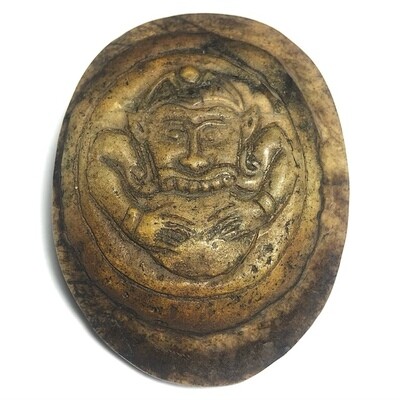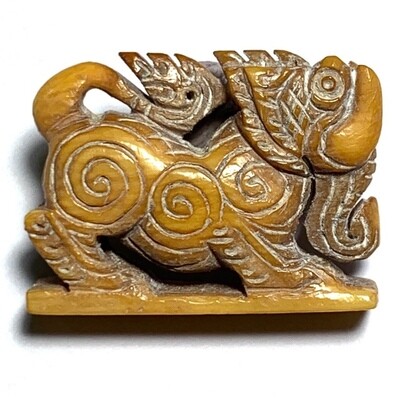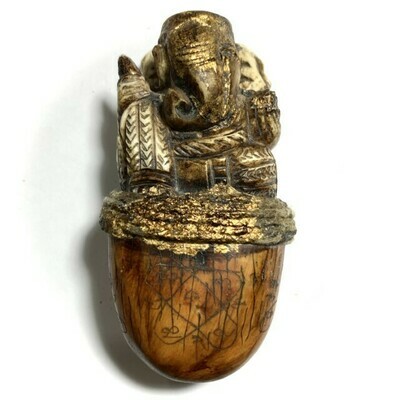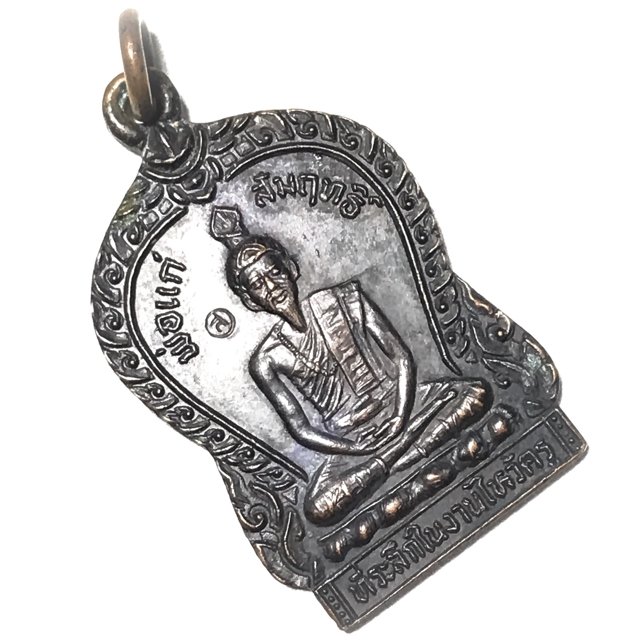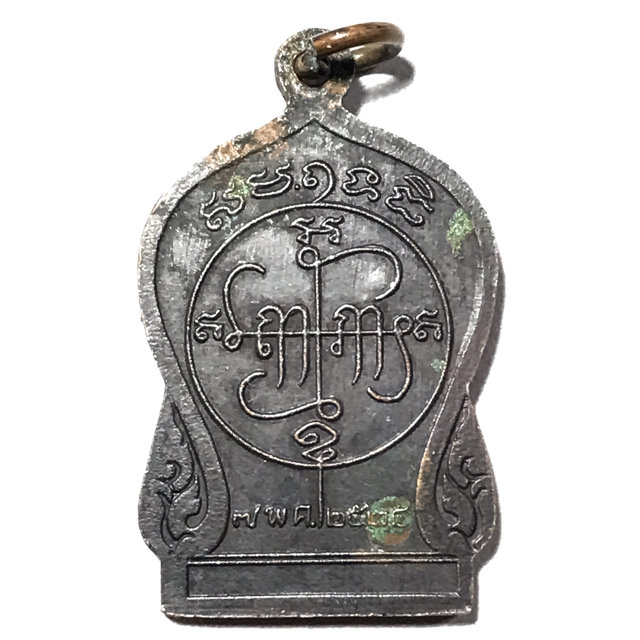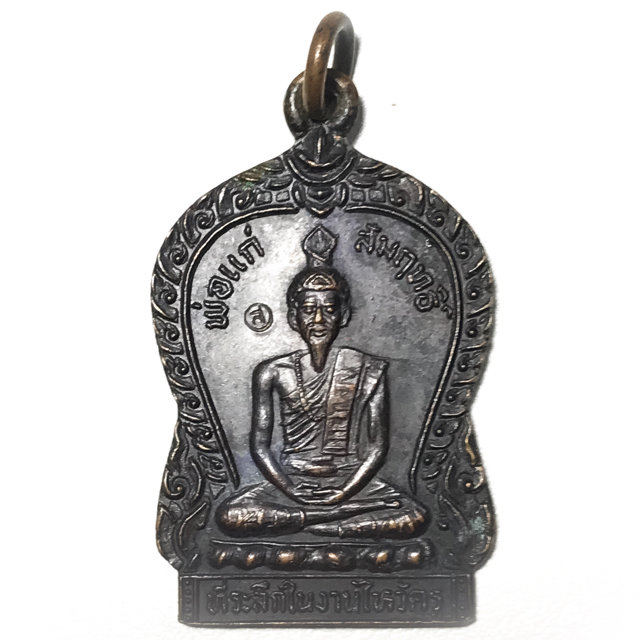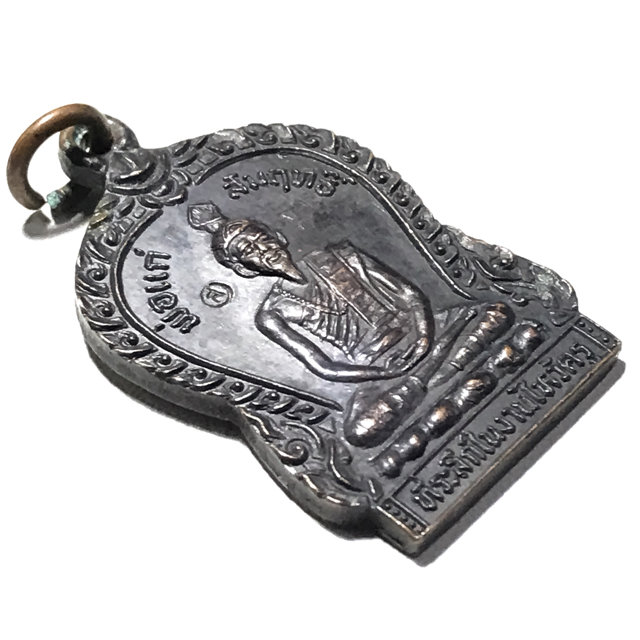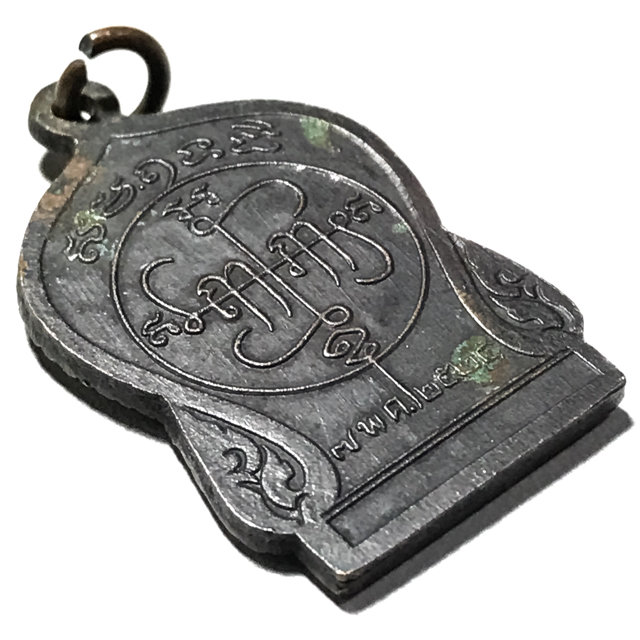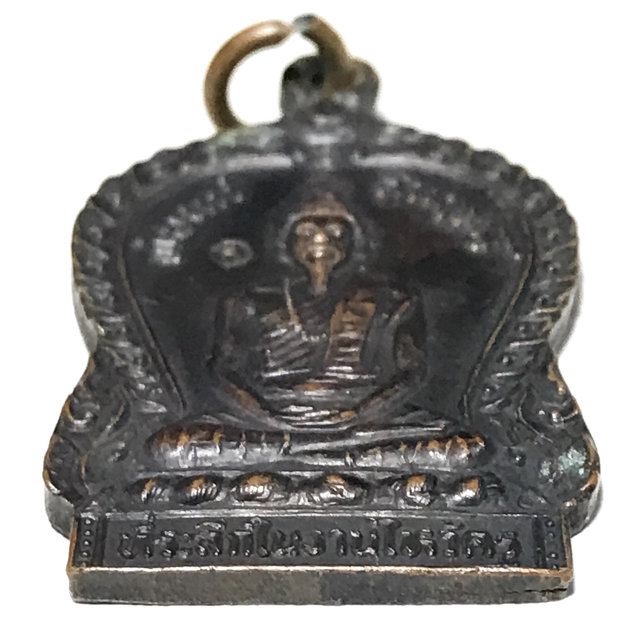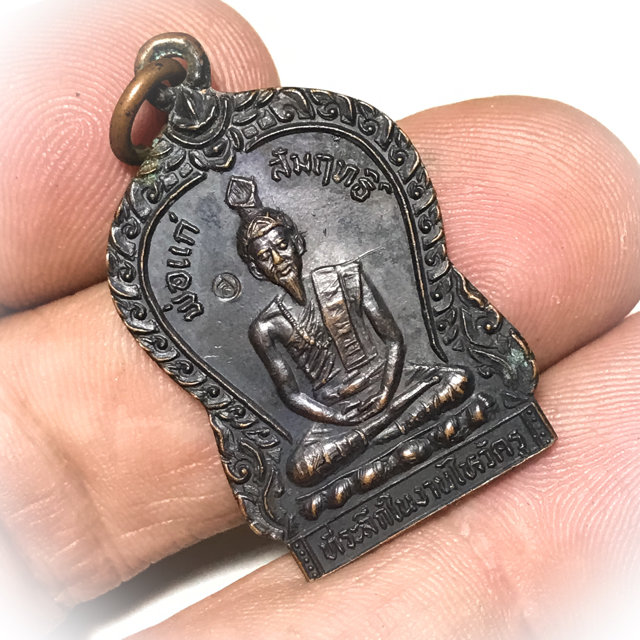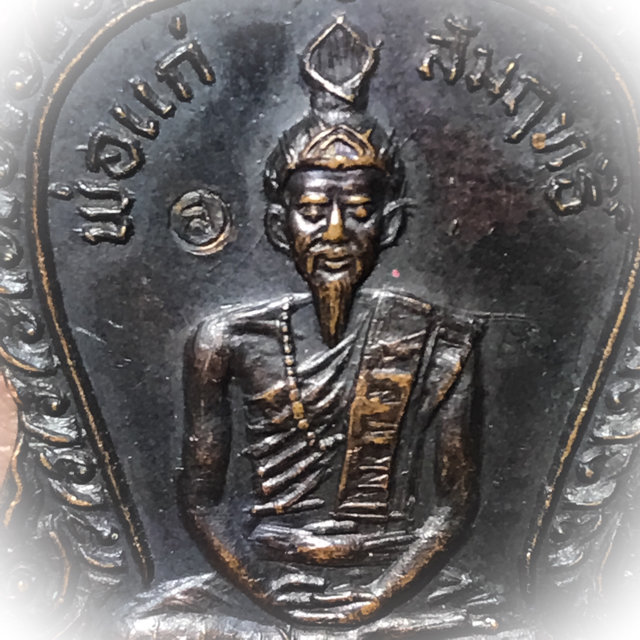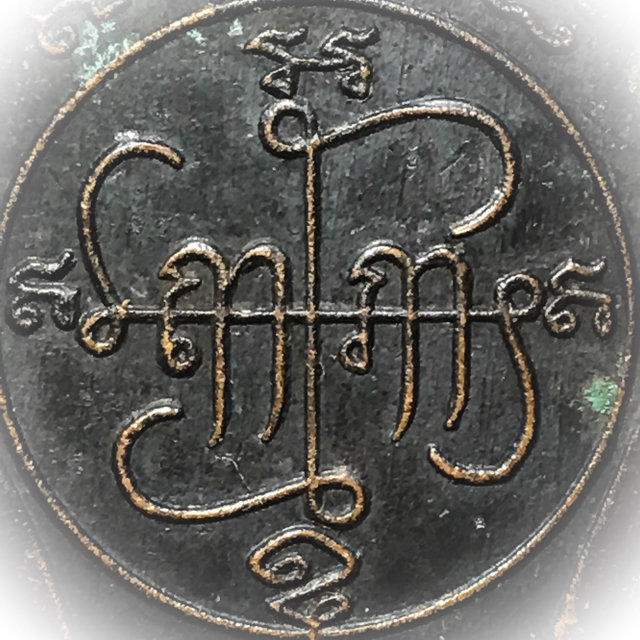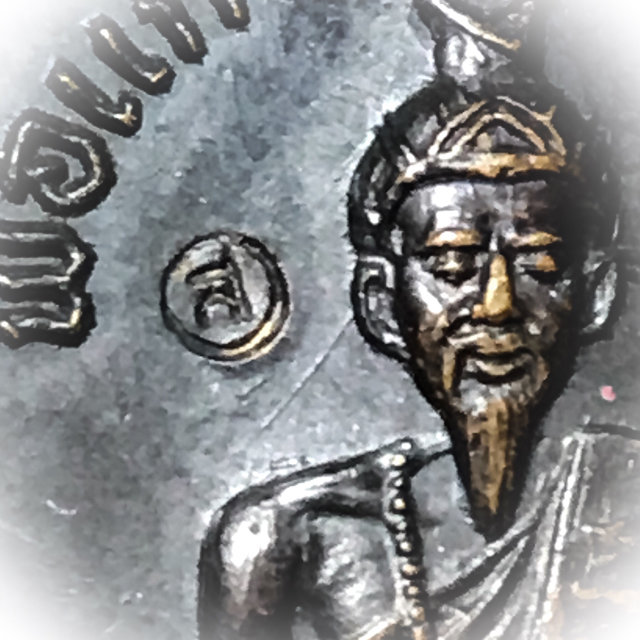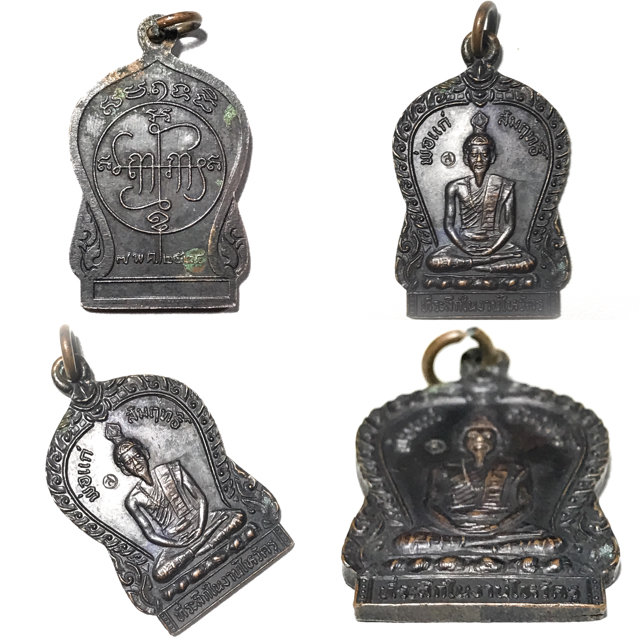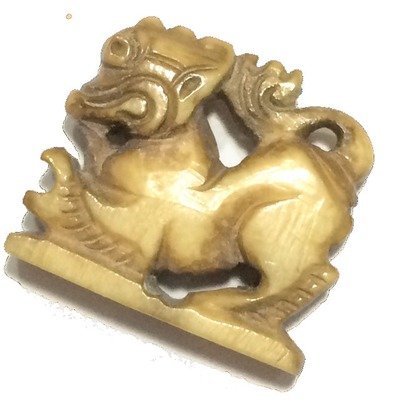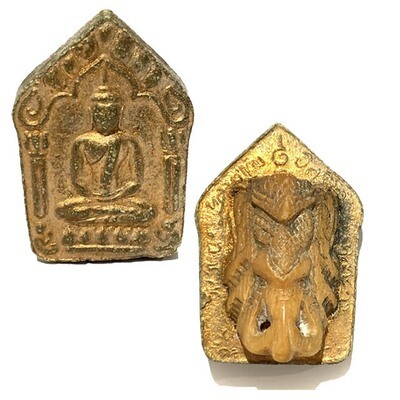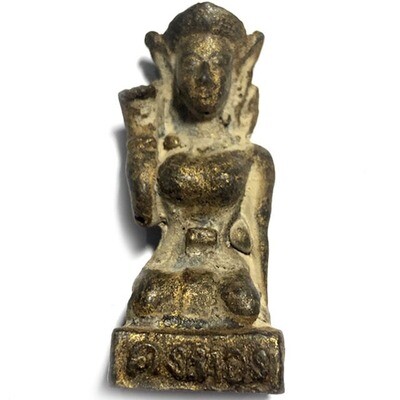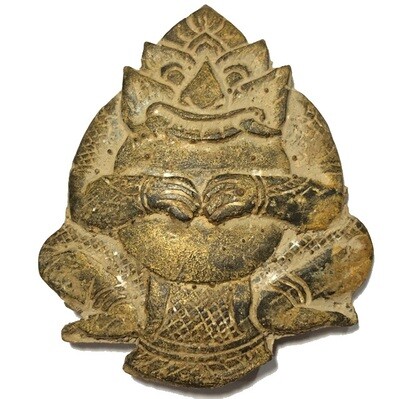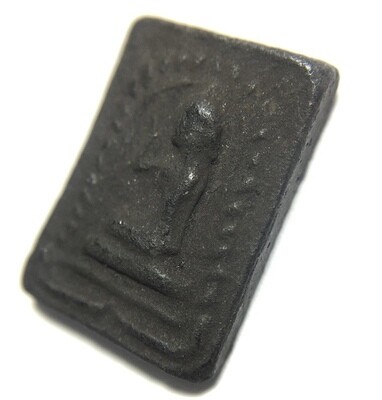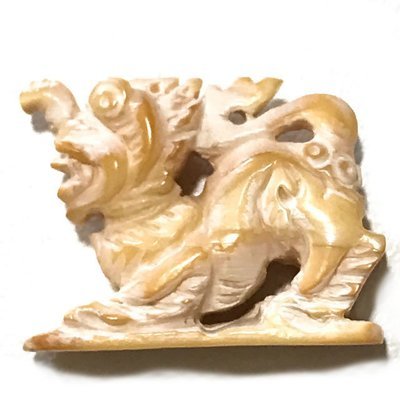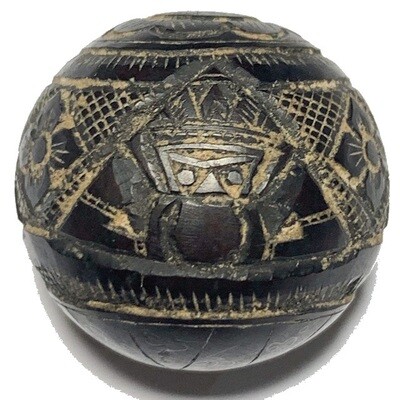Presenting a tiny but powerful and rare classic amulet from one of the Great Khao Or Masters of the 20th Century, Rian Glom Lek Hlang Chedi 2505 BE Nuea Tong Daeng Miniature Guru Monk Coin Por Tan Klai Wajasit
This Sacred amulet of the Great Khao Or Master of Nakorn Sri Tammarat, Master of Wat San Khan and Wat Pratat Noi, is a very rare amulet from Por Tan Klai’s 2505 BE Blessing Ceremony Edition, and is considered a ‘Jaek mae Krua’ type amulet (meaning ‘give to the kitchen maids and temple helpers’), which is suitable not only for men, but due to its miniature size, a perfect amulet for ladies or children to wear.

Rian Glom Lek 2505 BE Por Tan Klai Wajasit Wat Suan Khan
The 2505 BE edition of amulets of Por Tan Klai, is a highly preferred edition, which saw his famous ‘Rian Glom’ round Monk coin amulet with Chakra released, The Rian Glom Lek Hlang Chedi, and the Roop Tai Por Tan Klai Guru Monk Blesséd Photographamulets such as look om chan hmak and ya sen tobacco balls, and sacred powder amulets of various models.
A very rare and highly prized amulet for the devotees of Por Tan Klai to associate with his image and pray to him with a blessed image of the Guru, and the Chedi Relic Stupa on rear face for Buddhanussati and Marananussati. A powerful and Sacred amulet which has passed through the hands of the Guru and been blessed by him.
Por Tan Klai was one of the Top Guru Master Monks of the Last Century, and is considered one of the Four Great Masters of the Previous Generation of Lineage Masters of the Khao Or Southern Sorcery Lineage.
Kata Bucha Por Tan Klai
Rian Por Gae Samrit Niyom Dtok Code Sor Nuea Tong Daeng Rom Dam - Wai Kroo 2524 BE - Luang Por Say Wat Bang Rak Yai
Rian Por Gae Samrit (Hermit God Bestowing Blessings of success and prosperity) Run Tee Raleuk Wai Kroo 2524 BE (1981 Master Day Ceremony Edition) - Nuea Tong Daeng Rom Dam (Blackened Copper) - Hlang Yant Na Dtalok Hua Jai Pra Lersi (Enchantment Yantra with heart Mantra of the Lersi Hermit Gods on rear face) - Pim Niyom Dtok Code Sor (with ส Code stamp).
This amulet was released in the 2524 BE (1981) Master Day Ceremony to revere the Kroo Ba Ajarn Hermit Gods, and invoke their blessings in all areas of life for success and prosperity. The rear face of the coin bears the Yant Na Dtalok, with the Hua Jai Lersi (Leu-Leur) within the central area of the coin. The top of the coin has the word 'Samritti' in Khom Agkhara, which means 'Successfully Accomplished'. Below the Yantra, is the date of the Ceremony (27th May 2524 BE)
the front face of the coin bears the image of Por Gae Lersi seated in meditative posture. Above his head around the edges of the decorative arch are the words 'Por Gae Samrit' (Lersi of Success), and the preferred (Niyom) code stamp (ส), embossed into the face of the coin.
The Lersi/Ruesi
The Lersi Hermit Gods were the Devas who created the Earthly Arts and Sciences, and Bestowed them through transmission to the Denizens of earth. They Composed the Psalms of Heaven (the Tri Veda), which was in turn written down by the earthly Lersi (Rishi) who meditated and heard the Angelic Beings reciting these Psalms, and wrote them down.
The Lersi all are disciples of the 'Maha Rishi' (Great Lersi), the God Shiva, who is the highest of all Lersi sages. The Lersi serve to protect and improve all facets of life, as to Bucha the Pra Lersi Hermit God sages, is to Invoke Great Prosperity and Success into one's life. Por Gae Lersi, is a highly revered Thai Lersi Deity of Ancient Renown. There are many Legends about many different Lersi. One of the Lersi to be found so often mentioned in Thai Mythology, is Por Gae Lersi Dta Fai.
(Sometimes spelled “Pho Kae Ta Fai”). The legend of Highly Developed Beings has been told in different Mythologies and Cultures around the world. In Thailand there are also various legends of “Pu Wised”, or Lersi , Arahants or Yogis. These Lersi are said to have possessed various powers, such as Knowledge of herbal medicines, minerals, magical invocations, and supernatural abilities, such as Levitation, Teleportation, Alchemy, and Mind Reading.
These beings with special powers are reputed to have lived recluse lives in the forest, on mountains, or in caves; practicing meditative skills and mental development using secret methods passed on from mouth to ear by their fore-goers/masters. The Lersi, or also known as 'Ruesi', are the holders of the Great Kampira Grimoires, and Magical Wicha of the Dtamra Saiywaet, and are the Root Guru Masters of the Magical Tradition in Buddhist Thailand. Lersi Deva Hermit Gods are Revered in Thailand under the Name 'Por Gae'.
Por Gae defends these 'Wicha' Ethereal knowledge from both the ignorant who wish to destroy them, as well as the ignorant not ready to learn them. This Lersi commands respect and gives knowledge to those ready to accept the power that comes with the Lersi Path. Worshipping the Ruesi brings a full range of blessings and protective magic of the Boroma Kroo and the Immense Power and Protection of the 108 Ruesi Hermit Sages. Kong Grapan, Klaew Kaad, Gae Aathan, Gan Kun Sai, Choke Lap, Kaa Khaay, Metta Mahaniyom, Serm Duang, Maha Sanaeh.
All of these blessings are given with the practice of revering and following the Ruesi Devas. It requires somewhat more effort to practice revering the Ruesi, than to wear an amulet, because the practice of Revering Ruesi is a regular applied practice and you must think that the Ruesi are always with you, and that one lives and behaves as a Looksit of the Ruesi Boroma Kroo Por Gae. To Bucha the Ruesi brings Protection from physical and magical dangers (black magic) had Kong Grapan, Maha Ud and Klaew Klaad Properties.
Gae Aathan (remove Black Magic), Gan Phii (scare Ghosts away), Metta Mahaniyom (great preference and popularity), Maha Sanaeh (charm and hypnotic effect, attraction to the opposite sex). Serm Duang (invoke an auspicious fate and destiny, horoscope). Most traditional Lersi respect the Pantheon of Higher Beings according to the Brahmin tradition. Namely; Lord Brahma Shiva and Vishnu. Most Lersi practice the development of power and evocation/invocation(Peng Kasin). The word ‘Peng’, means in principle, to “stare”, but in this case, it really means to insert, or transform matter or substance, whether it be physical element, or a spiritual element.
Bpatawee Kasin (Pali – Paṭhavī), for example means to project earth element into a target/object. Bpatawee means Earth. To 'stare' earth element into water for example, would make it easy to walk upon its surface. Apo Kasin means to stare/project water (āpa means water element) – one technique used for example to master the evocation of water element would be to obtain clear water, such as rain water for example, and fill a clean container with it (not to the brim). After this meditate and stare ate the water until the inner experience of absorption with water occurs. once mastered the use of this mind evocation in conjunction with the Kata “Aapo Kasinang” will enable the master to evoke water element into another element , such as earth. Staring water into earth would allow a Lersi to dive under the earth and swim in it as if it was water.
This is in fact the technique used for Kong Grapan and Maha Ud, which is the effect of making a bullet harmless or a gun refuse to go off when the trigger is pulled.The solid (earth element object is turned into a soft watery element, and thus becomes harmless. In another fashion, also the hardness, impenetrability and density of stone/earth can be used to project into softer objects to increase Kong Grapan resistance.
Dtecho Kasin is the Fire Elemental. Fire Elemental serves to Master the element of fire and heat, and be able to set things on fire, or to heat them up, or even to douse out flames. This also refers to the Inner Yogic mastery of Inner Fire, which serves to alchemise magical incantations and other forms of magical creations on the inner planes, and to control the body on an elemental level with access to Jhanic Meditative Abilities.
Vayo Kasin is the Air Elemental. The emptiness, lightness and invisibility and swiftness of air and the wind, is incomparable as an elemental force, for it is impossible to catch or contain, and cannot be truly measured except by density, but never by size or location. The Mastery of the air element, brings control of the laws of Nature pertaining to wind and sky, allowing to levitate objects including oneself, and to change the density of objects and oneself in order to pass through walls etc.
On an Inner level, the Yogic ability and consciousness of the Mastery of the Inner Breath is achieved, and the portals to the four powers become open. Some Lersi may enter then on a secondary and higher path which goes beyond the 4 powers (Itiphada), and becomes the Magga (Path to Arahantship). The breath is air element within and without, and passes through us, empowering us with Life. Prana/Chi is the name of this power, and it is a central part of Yogic Practice, and the Key to Jhana Absorption Portal Access.
It is possible to evoke not only elements such as earth water fire and air, but also colors. Through Yogic mind development and the use of Kasin and Maha Amnaj (power), the Lersi have developed abilities such as being able to walk on the surface of the water (by evoking earth element into the water and transforming it to make it a hard surface over the spot where the Lersi is currently standing).
In the same way, one could also dive under the earth too, or float in the air, transport oneself instantly from one place to the other for example. This is probably what the ancient Alchemists (such as saint Germain) of the medieval Era were attempting to do. Other abilities achieved include divine ears and eyes (ability to see and hear things in other spheres/dimensions), read minds, and tell the future.
Of the Kasina Powers and Practices, there are ten different Kasina Objects of Meditative Focus;
The Kasina of Earth (paṭhavī kasiṇa)
The Kasina of Water (āpo kasiṇa)
The Kasina of Air, wind (vāyo kasiṇa)
The Kasina of Fire (tejo kasiṇa)
The Kasina of Blue and Green (nīla kasiṇa)
The Kasina of Yellow (pīta kasiṇa)
The Kasina of Red (lohita kasiṇa)
The Kasina of White (odāta kasiṇa)
The Kasina of Enclosed space, hole, aperture (ākāsa kasiṇa)
The Kasina of Luminosity (āloka kasiṇa)
The Ruesi Path is now becoming a very popular alternative to the General Buddhist path, because even a layperson or a married person is able to practice the Ruesi way, and advance within the framework of their own lifestyle. No ordination as Monk is necessary, but a true diligent attitude and effort to practice the Mindfulness path and the path of meditative skill and wisdom is crucial and must be applied.
Kata Bucha Lersi 108 - Compendium of Kata for different kinds of Lersi
Wai Kroo Lersi Kobutra
Always chant the Praise to Buddha first three times;
Na Mo Dtassa Pakawadto Arahadto Sammaa Samputtassa
Na Mo Dtassa Pakawadto Arahadto Sammaa Samputtassa
Na Mo Dtassa Pakawadto Arahadto Sammaa Samputtassa
Chant 3 times on your knees with palms placed together, and bowing each time, with each palm to the floor and your outstretched thumbs touching at the tips, this leaves just enough space for the forehead to bow down and touch the floor between your two hands.
Then chant the refuge in the triple gem until entering Nirvana – chant with with hands raised in prayer, and bow after each line is finished;
Refuge;
Puttang Cheewidtang Yaawanippaanang Saranang Kyajchaami (bow once)
Tammang Cheewidtang Yaawanippaanang Saranang Kyajchaami (bow once)
Sankang Cheewidtang Yaawanippaanang Saranang Kyajchaami (bow once)
Tudtiyambpi;
Puttang Cheewidtang Yaawanippaanang Saranang Kyajchaami (bow once)
Tammang Cheewidtang Yaawanippaanang Saranang Kyajchaami (bow once)
Sankang Cheewidtang Yaawanippaanang Saranang Kyajchaami (bow once)
Dtadtiyambpi;
Puttang Cheewidtang Yaawanippaanang Saranang Kyajchaami (bow once)
Tammang Cheewidtang Yaawanippaanang Saranang Kyajchaami (bow once)
Sankang Cheewidtang Yaawanippaanang Saranang Kyajchaami (bow once)
Then if you like to add more, you can chant all or any of the following Kata when and as you feel the wish or need, as additional Bucha
Short Kata to the 108 Ruesi;
Om Surawepoya Ruesi Poya Na Ma Ha
Kata to ask for the blessings of the Ruesi;
Om dtwa mewamaadtaa ja bpidtaa dtwa mewa dtwa mewa pantusaja sakhaa dtwa mewa dtwa mewa witayaa tarawinam dtwa mewa dtwa mewa sarawam ma ma tewa tewa
Kata Bucha Por Gae Ruesi Dta Fai
Ugaasa imang akkee paahoo buppang Ahang wantaa aajaariyang sappasayang winaassandti
Sittigaariya abparabpachaa imasaming pawandtume
Tudtiyambi – imang akkee paahoo buppang Ahang wantaa aajaariyang sappasayang winaassandti
Sittigaariya abparabpachaa imasaming pawandtume
Dtadtiyambpi – imang akkee paahoo buppang Ahang wantaa aajaariyang sappasayang winaassandti
Sittigaariya abparabpachaa imasaming pawandtume
Kata Bucha Ruesi Narai;
Om Imasaming Pra Bprakone Tap Pra Muneetewaa Hidtaa Dtumhe Bparipunchandtu
Tudtiyambpi – Imasaming Pra Bprakone Tap Pra Muneetewaa Hidtaa Dtumhe Bparipunchandtu
Dtadtiyambpi – Imasaming Pra Bprakone Tap Pra Muneetewaa Hidtaa Dtumhe Bparipunchandtu
General Kata (Good for all Ruesi)
Namasa Dtisadtawaa Isisitti Lokanaatathang
Anudt Dtarang Isee Ja Pantanang
Saadtraa Ahang Wantaami Dtang Isisittiwesa
Kata Lersi Hnaa Suea

